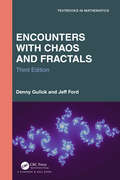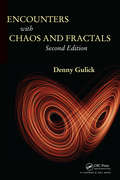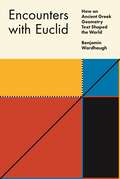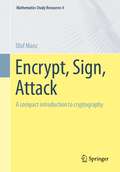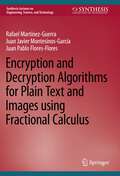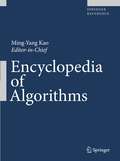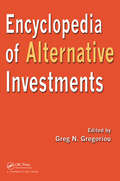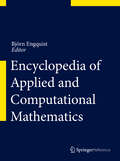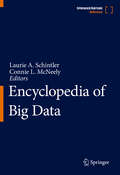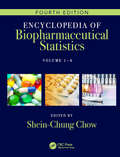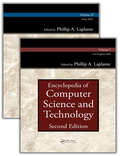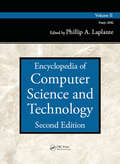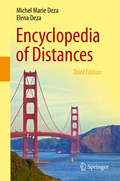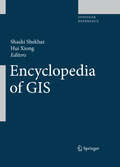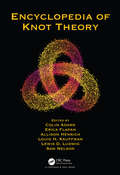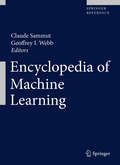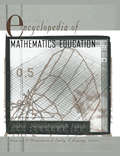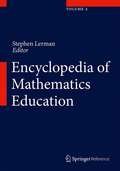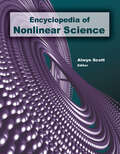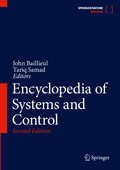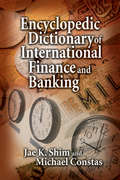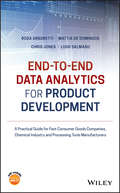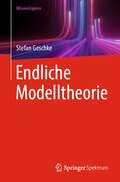- Table View
- List View
Encounters with Chaos and Fractals (Textbooks in Mathematics)
by Jeff Ford Denny GulickEncounters with Chaos and Fractals, Third Edition provides an accessible introduction to chaotic dynamics and fractal geometry. It incorporates important mathematical concepts and backs up the definitions and results with motivation, examples, and applications. The Third Edition updates this classic book for a modern audience. New applications on contemporary topics, like data science and mathematical modelling, appear throughout. Coding activities are transitioned to open-source programming languages, including Python. The text begins with examples of mathematical behavior exhibited by chaotic systems, first in one dimension and then in two and three dimensions. Focusing on fractal geometry, the authors introduce famous infinitely complicated fractals. How to obtain computer renditions of them are explained. The book concludes with Julia sets and the Mandelbrot set. The Third Edition includes: v More coding activities included in each section. The code is expanded to include pseudo-code, with specific examples in MATLAB (or it’s open-source cousin Octave) and Python. v Many more and updated exercises from previous editions. v Proof writing exercises for a more theoretical course. v Sections revised to include historical context. v Short sections added to explain applied problems developing the mathematics. This edition reveals how these ideas are continuing to be applied in the 21st century, while connecting to the long and winding history of dynamical systems. The primary focus is the beauty and diversity of these ideas. Offering more than enough material for a one-semester course, the authors show how these subjects continue to grow within mathematics and in many other disciplines.
Encounters with Chaos and Fractals (Textbooks in Mathematics)
by Denny GulickRevised and updated, this second edition provides an accessible introduction to both chaotic dynamics and fractal geometry for readers with a calculus background. This edition contains new and expanded material on fractals that illustrates how to obtain computer renderings of them and covers Julia and Mandelbrot sets. It also includes a substantial number of new exercises at the end of each section and MATLAB programs in the appendix, with selected solutions at the back of the book.
Encounters with Euclid: How an Ancient Greek Geometry Text Shaped the World
by Benjamin WardhaughA sweeping cultural history of one of the most influential mathematical books ever writtenEuclid's Elements of Geometry is one of the fountainheads of mathematics—and of culture. Written around 300 BCE, it has traveled widely across the centuries, generating countless new ideas and inspiring such figures as Isaac Newton, Bertrand Russell, Abraham Lincoln, and Albert Einstein. Encounters with Euclid tells the story of this incomparable mathematical masterpiece, taking readers from its origins in the ancient world to its continuing influence today.In this lively and informative book, Benjamin Wardhaugh explains how Euclid’s text journeyed from antiquity to the Renaissance, introducing some of the many readers, copyists, and editors who left their mark on the Elements before handing it on. He shows how some read the book as a work of philosophy, while others viewed it as a practical guide to life. He examines the many different contexts in which Euclid's book and his geometry were put to use, from the Neoplatonic school at Athens and the artisans' studios of medieval Baghdad to the Jesuit mission in China and the workshops of Restoration London. Wardhaugh shows how the Elements inspired ideas in theology, art, and music, and how the book has acquired new relevance to the strange geometries of dark matter and curved space.Encounters with Euclid traces the life and afterlives of one of the most remarkable works of mathematics ever written, revealing its lasting role in the timeless search for order and reason in an unruly world.
Encrypt, Sign, Attack: A compact introduction to cryptography (Mathematics Study Resources #4)
by Olaf ManzThis book explains compactly, without theoretical superstructure and with as little mathematical formalism as possible, the essential concepts in the encryption of messages and data worthy of protection. The focus is on the description of the historically and practically important cipher, signature and authentication methods. Both symmetric encryption and public-key ciphers are discussed. In each case, the strategies used to attack and attempt to "crack" encryption are also discussed. Special emphasis is placed on the practical use of ciphers, especially in the everyday environment. The book is suitable for working groups at STEM schools and STEM teacher training, for introductory courses at universities as well as for interested students and adults.
Encryption and Decryption Algorithms for Plain Text and Images using Fractional Calculus (Synthesis Lectures on Engineering, Science, and Technology)
by Rafael Martínez-Guerra Juan Javier Montesinos-García Juan Pablo Flores-FloresThis book offers an alternative for encrypting and decrypting messages using objects called integer and fractional-order estimators or observers, by means of security codes. The authors first establish the class of observers capable of carrying out this work. Then, the type of observers to treat either the integer or fractional order type and their main characteristics is mentioned. The book also presents an essential property of some systems such as Liouville, which is vital for the encryption and decryption of messages in integer and fractional order nonlinear systems by using the synchronization property of chaotic systems. Finally, it addresses some logistic maps such as Mandelbrot sets including Julia and fractal sets, taking advantage of their characteristics to encrypt or recover messages.
Encyclopedia of Algorithms
by Ming-Yang KaoOne of Springer's renowned Major Reference Works, this awesome achievement provides a comprehensive set of solutions to important algorithmic problems for students and researchers interested in quickly locating useful information. This first edition of the reference focuses on high-impact solutions from the most recent decade, while later editions will widen the scope of the work. All entries have been written by experts, while links to Internet sites that outline their research work are provided. The entries have all been peer-reviewed. This defining reference is published both in print and on line.
Encyclopedia of Alternative Investments
by Greg N. GregoriouA pioneering reference essential in any financial library, the Encyclopedia of Alternative Investments is the most authoritative source on alternative investments for students, researchers, and practitioners in this area. Containing 545 entries, the encyclopedia focuses on hedge funds, managed futures, commodities, and venture capital. It features
Encyclopedia of Applied and Computational Mathematics
by Björn EngquistEACM is a comprehensive reference work covering the vast field of applied and computational mathematics. Applied mathematics itself accounts for at least 60 per cent of mathematics, and the emphasis on computation reflects the current and constantly growing importance of computational methods in all areas of applications. EACM emphasizes the strong links of applied mathematics with major areas of science, such as physics, chemistry, biology, and computer science, as well as specific fields like atmospheric ocean science. In addition, the mathematical input to modern engineering and technology form another core component of EACM.
Encyclopedia of Big Data
by Connie L. McNeely Laurie A. SchintlerThis encyclopedia will be an essential resource for our times, reflecting the fact that we currently are living in an expanding data-driven world. Technological advancements and other related trends are contributing to the production of an astoundingly large and exponentially increasing collection of data and information, referred to in popular vernacular as “Big Data.” Social media and crowdsourcing platforms and various applications ― “apps” ― are producing reams of information from the instantaneous transactions and input of millions and millions of people around the globe. The Internet-of-Things (IoT), which is expected to comprise tens of billions of objects by the end of this decade, is actively sensing real-time intelligence on nearly every aspect of our lives and environment. The Global Positioning System (GPS) and other location-aware technologies are producing data that is specific down to particular latitude and longitude coordinates and seconds of the day. Large-scale instruments, such as the Large Hadron Collider (LHC), are collecting massive amounts of data on our planet and even distant corners of the visible universe. Digitization is being used to convert large collections of documents from print to digital format, giving rise to large archives of unstructured data. Innovations in technology, in the areas of Cloud and molecular computing, Artificial Intelligence/Machine Learning, and Natural Language Processing (NLP), to name only a few, also are greatly expanding our capacity to store, manage, and process Big Data. In this context, the Encyclopedia of Big Data is being offered in recognition of a world that is rapidly moving from gigabytes to terabytes to petabytes and beyond. While indeed large data sets have long been around and in use in a variety of fields, the era of Big Data in which we now live departs from the past in a number of key respects and with this departure comes a fresh set of challenges and opportunities that cut across and affect multiple sectors and disciplines, and the public at large. With expanded analytical capacities at hand, Big Data is now being used for scientific inquiry and experimentation in nearly every (if not all) disciplines, from the social sciences to the humanities to the natural sciences, and more. Moreover, the use of Big Data has been well established beyond the Ivory Tower. In today’s economy, businesses simply cannot be competitive without engaging Big Data in one way or another in support of operations, management, planning, or simply basic hiring decisions. In all levels of government, Big Data is being used to engage citizens and to guide policy making in pursuit of the interests of the public and society in general. Moreover, the changing nature of Big Data also raises new issues and concerns related to, for example, privacy, liability, security, access, and even the veracity of the data itself.Given the complex issues attending Big Data, there is a real need for a reference book that covers the subject from a multi-disciplinary, cross-sectoral, comprehensive, and international perspective. The Encyclopedia of Big Data will address this need and will be the first of such reference books to do so. Featuring some 500 entries, from "Access" to "Zillow," the Encyclopedia will serve as a fundamental resource for researchers and students, for decision makers and leaders, and for business analysts and purveyors. Developed for those in academia, industry, and government, and others with a general interest in Big Data, the encyclopedia will be aimed especially at those involved in its collection, analysis, and use. Ultimately, the Encyclopedia of Big Data will provide a common platform and language covering the breadth and depth of the topic for different segments, sectors, and disciplines.
Encyclopedia of Biopharmaceutical Statistics - Four Volume Set
by Shein-Chung ChowSince the publication of the first edition in 2000, there has been an explosive growth of literature in biopharmaceutical research and development of new medicines. This encyclopedia (1) provides a comprehensive and unified presentation of designs and analyses used at different stages of the drug development process, (2) gives a well-balanced summary of current regulatory requirements, and (3) describes recently developed statistical methods in the pharmaceutical sciences. Features of the Fourth Edition: 1. 78 new and revised entries have been added for a total of 308 chapters and a fourth volume has been added to encompass the increased number of chapters. 2. Revised and updated entries reflect changes and recent developments in regulatory requirements for the drug review/approval process and statistical designs and methodologies. 3. Additional topics include multiple-stage adaptive trial design in clinical research, translational medicine, design and analysis of biosimilar drug development, big data analytics, and real world evidence for clinical research and development. 4. A table of contents organized by stages of biopharmaceutical development provides easy access to relevant topics. About the Editor: Shein-Chung Chow, Ph.D. is currently an Associate Director, Office of Biostatistics, U.S. Food and Drug Administration (FDA). Dr. Chow is an Adjunct Professor at Duke University School of Medicine, as well as Adjunct Professor at Duke-NUS, Singapore and North Carolina State University. Dr. Chow is the Editor-in-Chief of the Journal of Biopharmaceutical Statistics and the Chapman & Hall/CRC Biostatistics Book Series and the author of 28 books and over 300 methodology papers. He was elected Fellow of the American Statistical Association in 1995.
Encyclopedia of Computer Science and Technology
by Phillip A. LaplanteWith breadth and depth of coverage, the Encyclopedia of Computer Science and Technology, Second Edition has a multi-disciplinary scope, drawing together comprehensive coverage of the inter-related aspects of computer science and technology. The topics covered in this encyclopedia include: General and reference Hardware Computer systems organization Networks Software and its engineering Theory of computation Mathematics of computing Information systems Security and privacy Human-centered computing Computing methodologies Applied computing Professional issues Leading figures in the history of computer science The encyclopedia is structured according to the ACM Computing Classification System (CCS), first published in 1988 but subsequently revised in 2012. This classification system is the most comprehensive and is considered the de facto ontological framework for the computing field. The encyclopedia brings together the information and historical context that students, practicing professionals, researchers, and academicians need to have a strong and solid foundation in all aspects of computer science and technology.
Encyclopedia of Computer Science and Technology Volume II
by Phillip A. LaplanteThis book covers all aspects of computer science, engineering, and technology. It includes computer scientists, computer engineers computing professionals, managers, software professionals, and other technology professionals.
Encyclopedia of Distances
by Michel Marie Deza Elena DezaThis 4-th edition of the leading reference volume on distance metrics is characterized by updated and rewritten sections on some items suggested by experts and readers, as well a general streamlining of content and the addition of essential new topics. Though the structure remains unchanged, the new edition also explores recent advances in the use of distances and metrics for e. g. generalized distances, probability theory, graph theory, coding theory, data analysis. New topics in the purely mathematical sections include e. g. the Vitanyi multiset-metric, algebraic point-conic distance, triangular ratio metric, Rossi-Hamming metric, Taneja distance, spectral semimetric between graphs, channel metrization, and Maryland bridge distance. The multidisciplinary sections have also been supplemented with new topics, including: dynamic time wrapping distance, memory distance, allometry, atmospheric depth, elliptic orbit distance, VLBI distance measurements, the astronomical system of units, and walkability distance. Leaving aside the practical questions that arise during the selection of a 'good' distance function, this work focuses on providing the research community with an invaluable comprehensive listing of the main available distances. As well as providing standalone introductions and definitions, the encyclopedia facilitates swift cross-referencing with easily navigable bold-faced textual links to core entries. In addition to distances themselves, the authors have collated numerous fascinating curiosities in their Who's Who of metrics, including distance-related notions and paradigms that enable applied mathematicians in other sectors to deploy research tools that non-specialists justly view as arcane. In expanding access to these techniques, and in many cases enriching the context of distances themselves, this peerless volume is certain to stimulate fresh research.
Encyclopedia of Finance
by Cheng-Few Lee Alice C. LeeThe Encyclopedia of Finance, Second Edition, comprised of over 1000 individual definitions and chapters, is the most comprehensive and up-to-date resource in the field, integrating the most current terminology, research, theory, and practical applications. Showcasing contributions from an international array of experts, the revised edition of this major reference work is unparalleled in the breadth and depth of its coverage. Part I provides readers with a basic framework for getting up to speed quickly, and has been updated to include over 200 new terms and essays. Part II features 24 new chapters and offers a more in-depth look at the topic through key developments and findings. Part III has also been expanded through the addition of four new appendices. From "asset pricing models" to "risk management," the Encyclopedia of Finance, Second Edition, serves as an essential resource for academics, educators, and students.
Encyclopedia of GIS
by Shashi Shekhar Hui XiongThe Encyclopedia of GIS provides a comprehensive and authoritative guide, contributed by experts and peer-reviewed for accuracy, and alphabetically arranged for convenient access. The entries explain key software and processes used by geographers and computational scientists. Major overviews are provided for nearly 200 topics: Geoinformatics, Spatial Cognition, and Location-Based Services and more. Shorter entries define specific terms and concepts. The reference will be published as a print volume with abundant black and white art, and simultaneously as an XML online reference with hyperlinked citations, cross-references, four-color art, links to web-based maps, and other interactive features.
Encyclopedia of Knot Theory
by Colin Adams Louis H. Kauffman Erica Flapan Allison Henrich Lewis D. Ludwig Sam Nelson"Knot theory is a fascinating mathematical subject, with multiple links to theoretical physics. This enyclopedia is filled with valuable information on a rich and fascinating subject." – Ed Witten, Recipient of the Fields Medal "I spent a pleasant afternoon perusing the Encyclopedia of Knot Theory. It’s a comprehensive compilation of clear introductions to both classical and very modern developments in the field. It will be a terrific resource for the accomplished researcher, and will also be an excellent way to lure students, both graduate and undergraduate, into the field." – Abigail Thompson, Distinguished Professor of Mathematics at University of California, Davis Knot theory has proven to be a fascinating area of mathematical research, dating back about 150 years. Encyclopedia of Knot Theory provides short, interconnected articles on a variety of active areas in knot theory, and includes beautiful pictures, deep mathematical connections, and critical applications. Many of the articles in this book are accessible to undergraduates who are working on research or taking an advanced undergraduate course in knot theory. More advanced articles will be useful to graduate students working on a related thesis topic, to researchers in another area of topology who are interested in current results in knot theory, and to scientists who study the topology and geometry of biopolymers. Features Provides material that is useful and accessible to undergraduates, postgraduates, and full-time researchers Topics discussed provide an excellent catalyst for students to explore meaningful research and gain confidence and commitment to pursuing advanced degrees Edited and contributed by top researchers in the field of knot theory
Encyclopedia of Machine Learning
by Claude Sammut Geoffrey I. WebbThis comprehensive encyclopedia, in A-Z format, provides easy access to relevant information for those seeking entry into any aspect within the broad field of Machine Learning. Most of the entries in this preeminent work include useful literature references.
Encyclopedia of Mathematics Education
by Louise Grinstein Sally I. LipseyThis single-volume reference is designed for readers and researchers investigating national and international aspects of mathematics education at the elementary, secondary, and post-secondary levels. It contains more than 400 entries, arranged alphabetically by headings of greatest pertinence to mathematics education. The scope is comprehensive, encompassing all major areas of mathematics education, including assessment, content and instructional procedures, curriculum, enrichment, international comparisons, and psychology of learning and instruction.
Encyclopedia of Mathematics Education
by Stephen LermanThe Encyclopedia of Mathematics Education is a comprehensive reference text, covering every topic in the field with entries ranging from short descriptions to much longer pieces where the topic warrants more elaboration. The entries provide access to theories and to research in the area and refer to the leading publications for further reading. Links will also be made to particular texts in Springer journals and e-books through SpringerReference. com. The Encyclopedia is aimed at graduate students, researchers, curriculum developers, policy makers, and others with interests in the field of mathematics education. It is planned to be 700 pages in length in its hard copy form but the text will subsequently be up-dated and developed on-line in a way that retains the integrity of the ideas, the responsibility for which will be in the hands of the Editor-in-Chief and the Editorial Board. Editorial Board: Michele ArtigueRuhama EvenMelony GravenEva JablonkaRobyn JorgensenYoshinori ShimizuBharath Sriraman
Encyclopedia of Nonlinear Science
by Alwyn ScottIn 438 alphabetically-arranged essays, this work provides a useful overview of the core mathematical background for nonlinear science, as well as its applications to key problems in ecology and biological systems, chemical reaction-diffusion problems, geophysics, economics, electrical and mechanical oscillations in engineering systems, lasers and nonlinear optics, fluid mechanics and turbulence, and condensed matter physics, among others.
Encyclopedia of Software Engineering Three-Volume Set (Print)
by Phillip A. LaplanteSoftware engineering requires specialized knowledge of a broad spectrum of topics, including the construction of software and the platforms, applications, and environments in which the software operates as well as an understanding of the people who build and use the software. Offering an authoritative perspective, the two volumes of the Encyclopedia of Software Engineering cover the entire multidisciplinary scope of this important field. More than 200 expert contributors and reviewers from industry and academia across 21 countries provide easy-to-read entries that cover software requirements, design, construction, testing, maintenance, configuration management, quality control, and software engineering management tools and methods. Editor Phillip A. Laplante uses the most universally recognized definition of the areas of relevance to software engineering, the Software Engineering Body of Knowledge (SWEBOK®), as a template for organizing the material. Also available in an electronic format, this encyclopedia supplies software engineering students, IT professionals, researchers, managers, and scholars with unrivaled coverage of the topics that encompass this ever-changing field. Also Available OnlineThis Taylor & Francis encyclopedia is also available through online subscription, offering a variety of extra benefits for researchers, students, and librarians, including: Citation tracking and alerts Active reference linking Saved searches and marked lists HTML and PDF format options Contact Taylor and Francis for more information or to inquire about subscription options and print/online combination packages.US: (Tel) 1.888.318.2367; (E-mail) e-reference@taylorandfrancis.comInternational: (Tel) +44 (0) 20 7017 6062; (E-mail) online.sales@tandf.co.uk
Encyclopedia of Systems and Control
by John Baillieul Tariq SamadThe Encyclopedia of Systems and Control collects a broad range of short expository articles that describe the current state of the art in the central topics of control and systems engineering as well as in many of the related fields in which control is an enabling technology. The editors have assembled the most comprehensive reference possible, and this has been greatly facilitated by the publisher’s commitment to continuously publish updates to the articles as they become available in the future. Although control engineering is now a mature discipline, it remains an area in which there is a great deal of research activity, and as new developments in both theory and applications become available, they will be included in the online version of the encyclopedia. A carefully chosen team of leading authorities in the field has written the well over 300 articles, 50 of them new in the second edition. The topics range from basic principles of feedback in servomechanisms to advanced topics such as the control of Boolean networks and evolutionary game theory and this range has also been expanded to include material on such subjects as the Internet of Things, quantum control and smart grids. Because the content has been selected to reflect both foundational importance and subjects that are of current interest to the research and practitioner communities, a broad readership that includes students, application engineers, and research scientists will find entries that are of interest.
Encyclopedic Dictionary of International Finance and Banking
by Jae K. Shim Michael ConstasThe Encyclopedic Dictionary of International Finance and Banking is a practical reference of proven techniques, strategies, and approaches. It covers virtually all important topics dealing with multinational business finance, money, investments, financial planning, financial economics, and banking. In addition, it explores the application of comput
End-to-end Data Analytics for Product Development: A Practical Guide for Fast Consumer Goods Companies, Chemical Industry and Processing Tools Manufacturers (Wiley Series In Probability And Statistics Ser. #564)
by Chris Jones Luigi Salmaso Rosa Arboretti Giancristofaro Mattia De DominicisAn interactive guide to the statistical tools used to solve problems during product and process innovation End to End Data Analytics for Product Development is an accessible guide designed for practitioners in the industrial field. It offers an introduction to data analytics and the design of experiments (DoE) whilst covering the basic statistical concepts useful to an understanding of DoE. The text supports product innovation and development across a range of consumer goods and pharmaceutical organizations in order to improve the quality and speed of implementation through data analytics, statistical design and data prediction. The book reviews information on feasibility screening, formulation and packaging development, sensory tests, and more. The authors – noted experts in the field – explore relevant techniques for data analytics and present the guidelines for data interpretation. In addition, the book contains information on process development and product validation that can be optimized through data understanding, analysis and validation. The authors present an accessible, hands-on approach that uses MINITAB and JMP software. The book: • Presents a guide to innovation feasibility and formulation and process development • Contains the statistical tools used to solve challenges faced during product innovation and feasibility • Offers information on stability studies which are common especially in chemical or pharmaceutical fields • Includes a companion website which contains videos summarizing main concepts Written for undergraduate students and practitioners in industry, End to End Data Analytics for Product Development offers resources for the planning, conducting, analyzing and interpreting of controlled tests in order to develop effective products and processes.
Endliche Modelltheorie
by Stefan GeschkeDieses Buch basiert auf dem Skript zu einer Vorlesung über endliche Modelltheorie an der Freien Universität Berlin und dient als eine kurze Einführung in das Thema. Vorausgesetzt wird dabei eine gewisse Vertrautheit mit mathematischer Notation und grundlegenden Konzepten, wie zum Beispiel Mengen, die man in einer einführenden Mathematikvorlesung für Studierende der Mathematik, Informatik oder der Naturwissenschaften erwirbt. Ausdrücklich nicht vorausgesetzt werden Kenntnisse in mathematischer Logik.Die Produktfamilie WissensExpress bietet Ihnen Lehr- und Lernbücher in kompakter Form. Die Bücher liefern schnell und verständlich fundiertes Wissen.
